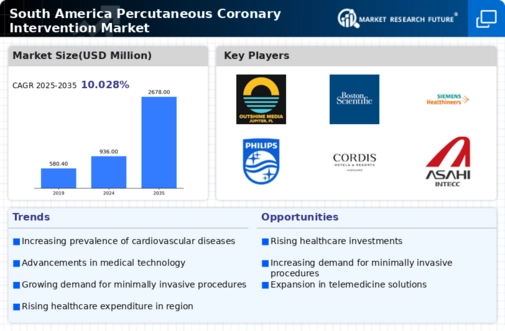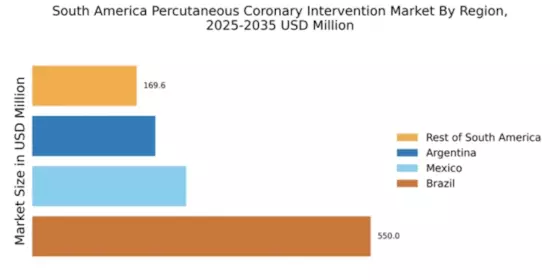Aging Population
The demographic shift towards an aging population in South America is critically impacting the percutaneous coronary-intervention market. As individuals age, the risk of developing cardiovascular diseases increases, leading to a higher demand for interventions. Projections indicate that by 2030, the proportion of individuals aged 65 and older in South America will rise to over 15%. This demographic trend suggests a growing patient base for percutaneous coronary interventions, as older adults are more likely to require such procedures. Healthcare systems are thus compelled to adapt to this changing landscape by enhancing their capabilities to perform these interventions. The aging population, therefore, represents a critical driver for the percutaneous coronary-intervention market, as it necessitates a focus on cardiovascular health.
Growing Healthcare Expenditure
In South America, the percutaneous coronary-intervention market is benefiting from the growing healthcare expenditure across various countries. Governments and private sectors are increasingly investing in healthcare infrastructure, which includes the procurement of advanced medical devices and technologies. Reports indicate that healthcare spending in the region has risen by approximately 5% annually, reflecting a commitment to improving health outcomes. This increase in funding allows for better access to percutaneous coronary interventions, as more facilities are equipped to perform these procedures. Additionally, the rise in disposable income among the population is enabling more individuals to seek elective procedures, further propelling market growth. The combination of increased healthcare investment and rising consumer spending is likely to create a favorable environment for the percutaneous coronary-intervention market.
Increased Awareness and Education
In South America, there is a notable increase in awareness and education regarding cardiovascular health, which is positively influencing the percutaneous coronary-intervention market. Public health campaigns and educational initiatives are effectively informing the population about the risks associated with heart diseases and the benefits of timely interventions. This heightened awareness is leading to earlier diagnosis and treatment, which is crucial for improving patient outcomes. As more individuals recognize the importance of cardiovascular health, the demand for percutaneous coronary interventions is likely to rise. Additionally, healthcare professionals are increasingly emphasizing preventive measures and early intervention strategies, further driving the market. The synergy between public awareness and professional education is expected to foster growth in the percutaneous coronary-intervention market.
Advancements in Medical Technology
Technological innovations are playing a pivotal role in shaping the percutaneous coronary-intervention market in South America. The introduction of advanced catheter systems, imaging techniques, and drug-eluting stents has significantly improved the efficacy and safety of these procedures. For instance, the use of real-time imaging during interventions enhances precision, reducing complications and improving patient outcomes. As hospitals and clinics adopt these cutting-edge technologies, the market is expected to witness substantial growth. Moreover, the increasing collaboration between medical device manufacturers and healthcare providers is likely to accelerate the development of new products tailored to the specific needs of the South American population. This trend indicates a promising future for the percutaneous coronary-intervention market, as technological advancements continue to evolve.
Rising Incidence of Heart Diseases
The percutaneous coronary-intervention market in South America is experiencing growth due to the rising incidence of heart diseases. Cardiovascular diseases are among the leading causes of mortality in the region, with estimates suggesting that they account for approximately 30% of all deaths. This alarming trend necessitates effective treatment options, thereby driving demand for percutaneous coronary interventions. As healthcare providers seek to address this public health challenge, the market is likely to expand. Furthermore, the increasing awareness of heart health among the population is prompting more individuals to seek medical attention, which could further boost the percutaneous coronary-intervention market. The combination of rising disease prevalence and heightened awareness strongly supports the need for increased investment in the percutaneous coronary-intervention sector.


















Leave a Comment